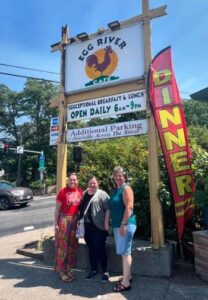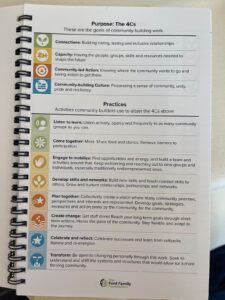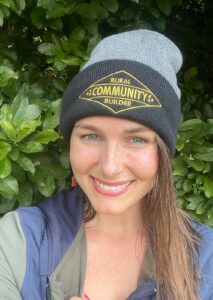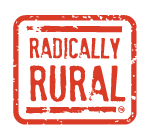Showing up. Those are the words I first think of when I remember the fantastic meeting we had with Michelle Martin and Alicia Flory from The Ford Family Foundation (TFFF), a community foundation based in Roseburg, OR. 
Leading up to the trip, I was reflecting on who I could connect with in Oregon. I knew in prior years we had a couple of attendees from the Ford Family Foundation and I was thrilled when I discovered that they were within driving distance of Hood River. I don’t know about all of you, but for me, I often feel like I’m “unworthy” of others’ time and efforts. When I sent out the invitation it was very “I know you’re busy” and “We could drive further to your side” and such. What did I get back? “YES!” and “We’ll come all the way to you!” and “Let us take you out to lunch!” At that moment it clicked for me that a good portion of the ingredients for the rural community building recipe is simply…showing up.
That’s what we do at Radically Rural too, over and over. We never know what combinations of ingredients will yield important outcomes for our communities, so we keep showing up, and so do you.
I asked them why they chose to fly across the country and attend Radically Rural. Among other things, they were inspired by the way the conference is organized, using the whole downtown as the conference site; they shared that that concept has made them rethink which towns they can include as hosting sites for their own events. Further, as a community foundation providing funding for lots of different projects, they love the cross-sector nature of the summit. For example, while they are not journalists themselves, they support journalists in Oregon. They love learning innovative approaches and solutions, such as the Press Club at Kansas Publishing Ventures that we heard about during last year’s Community Journalism session: How’d They Do That? Building Sustainability.
Besides the delightful company and delicious food at Egg River Cafe, hearing about TFFF history and the innovative models they themselves are using for their work as a community foundation was incredibly inspiring. I’ll highlight just a few here:
- The annual Oregon by the Numbers report features “a detailed profile for each of Oregon’s 36 counties. Summaries of each measure of community well-being include county rankings and rural and urban comparisons when available. We provide quality data that decision-makers across all of Oregon’s diverse communities can use to take action. Our goal is to help all of Oregon see all of Oregon.”
- Oregon voices household survey, which is designed to gather quantitative and qualitative data from OR residents about healthcare, housing, family financial stability, and more. The survey spans Oregon’s 36 counties and has shareable results, regardless of their population size. It’s special in that it focuses on people’s lived experiences, pairing statistics with personal stories. They say, “We hope the data will set the table for conversations in backyards, town halls, schools, workplaces, county fairs and in our State Capitol.” In total, more than 4,000 households submitted a survey across two data collection phases; over 1,000 of these were completed on paper.
- Last year at Radically Rural, Chris Estes presented on Aspen’s Thrive Rural Framework. TFFF has their own framework called “Community Building Approach”. It’s simple and approachable, divided into four principals and eight practices. They say, “We know that rural residents hold the wisdom about how to improve the well-being of children and families in their communities. We support residents…as they take the lead in building their communities’ futures.”


Ultimately, what they are doing is working. They have 90 hub communities they support. 16 years ago they had 15 staff members; they now have 52. The community foundation infrastructure they have set up is incredibly responsive. For example, in the 2020 fires, they had funding out the door within 24 hours. Their state is a childcare desert so they support relevant initiatives, like a coalition in Douglas county that supports childcare providers.
After getting home, we got a sweet package of swag in the mail with a handwritten note. I’ve been carrying my “rural community builder” notebook with me and keeping the joy of meaningful cross country relationships in my heart. No one needs to do this work alone, we don’t need to fight to “own” rural work. We need to keep learning, keep sharing, keep evolving, and above all, keep showing up.

More about The Ford Family Foundation:
The four program departments are:
- Children, Youth and Families
- Community Economic Development
- Postsecondary Success
- Rural Community Building
Their three impact areas are:
- Family
- Education
- Community
“We have spent more than 25 years learning alongside our rural neighbors and partners about what works in our region. The relationships we have developed over time guide us in everything we do.
We invest in people – through scholarships, training and leadership development. We make grants to organizations in hopes of strengthening social and economic supports for children and families. We undertake community building to help rural residents build the futures they want to see and create vibrant places everyone is proud to call home.
We know the larger context matters too, especially in our region, where most of the population is concentrated in a handful of cities but most of the geography is vast and sparsely populated. We work to ensure that statewide policies and systems operate effectively to support children, families and communities. We proudly embrace our role as a rural advocate, encouraging statewide attention to rural people and places.” The tool used for much of this work is access to high-quality rural data.
Written by Radically Rural Director, Julianna Dodson.
